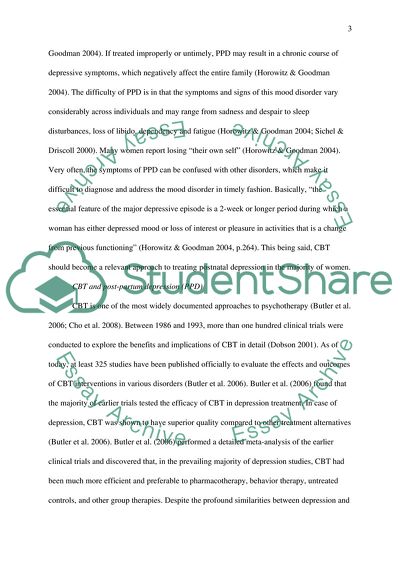Cite this document
(How Effective Is Cognitive Behavioral Therapy Compared to Other Literature review Example | Topics and Well Written Essays - 2500 words - 1, n.d.)
How Effective Is Cognitive Behavioral Therapy Compared to Other Literature review Example | Topics and Well Written Essays - 2500 words - 1. https://studentshare.org/psychology/1762242-how-effective-is-cognitive-behaviour-therapy-compare-to-other-psychological-therapies-and-pharmacological-options-in-treatment-of-postnatal-depression
How Effective Is Cognitive Behavioral Therapy Compared to Other Literature review Example | Topics and Well Written Essays - 2500 words - 1. https://studentshare.org/psychology/1762242-how-effective-is-cognitive-behaviour-therapy-compare-to-other-psychological-therapies-and-pharmacological-options-in-treatment-of-postnatal-depression
(How Effective Is Cognitive Behavioral Therapy Compared to Other Literature Review Example | Topics and Well Written Essays - 2500 Words - 1)
How Effective Is Cognitive Behavioral Therapy Compared to Other Literature Review Example | Topics and Well Written Essays - 2500 Words - 1. https://studentshare.org/psychology/1762242-how-effective-is-cognitive-behaviour-therapy-compare-to-other-psychological-therapies-and-pharmacological-options-in-treatment-of-postnatal-depression.
How Effective Is Cognitive Behavioral Therapy Compared to Other Literature Review Example | Topics and Well Written Essays - 2500 Words - 1. https://studentshare.org/psychology/1762242-how-effective-is-cognitive-behaviour-therapy-compare-to-other-psychological-therapies-and-pharmacological-options-in-treatment-of-postnatal-depression.
“How Effective Is Cognitive Behavioral Therapy Compared to Other Literature Review Example | Topics and Well Written Essays - 2500 Words - 1”. https://studentshare.org/psychology/1762242-how-effective-is-cognitive-behaviour-therapy-compare-to-other-psychological-therapies-and-pharmacological-options-in-treatment-of-postnatal-depression.


